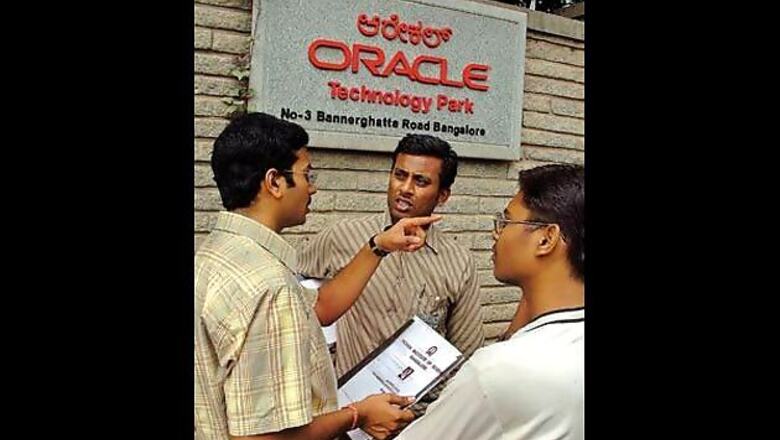
views
India will have a GDP (gross domestic product) of close to $2 trillion by March 2012. She is expected to more than double her GDP in the next 10 years. With a formal-sector employment of over 80 million, more than 100 million jobs in the formal sector will be created in the next 10 years not only due to growth, but also to fill in the large-scale retirement in the government and public sector over this period. The big challenge will be creating the right kind of skilled human resources to meet the demands of our economy.
India has built up an enviable higher educational infrastructure, though much below her needs. We have today about 530 universities, nearly 26,000 colleges and 16-plus million students in the system. The gross enrolment rate is reportedly at around 17 per cent in the age group of 18-24, though below the 30 per cent we need.
Today, we have over 3,500 engineering colleges, with over 1.5 million seats and over 3 million students in the engineering colleges. We have over 300,000 in the business management colleges as well. The challenge is to make sure the output of these colleges is ready to meet the needs of employers. All evidence points to the contrary as the gap between skills, employment needs and the quality of the output continues to widen.
There is need for a drastically different strategy to bridge this gap and a need for the intervention of the government, academia and industry. A case study of what Infosys did to bring about a transformation would provide guidance for this strategy.
It was about eight years ago that Infosys set up the Campus Connect programme to improve the quality of output from engineering colleges. A simple agreement was made with management wherein they participated in the programme and Infosys committed to train their faculty in IT, give them the Infosys training curriculum free of cost, created a portal to enable students get access to all collateral, provided soft skills training and expert lectures, sabbaticals for faculty in their corporate training facility and other benefits free of cost. The strategy was to make a systemic intervention, upgrade faculty capability, hold courses in the colleges to make students employment-ready based on industry needs, improve the curriculum based on current needs and generally upgrade capability in these colleges. There were no conditions on the colleges, except that of full participation.
Infosys also worked with national regulators and universities to upgrade the curriculum and to use IT as the basic platform to teach engineering. In eight years, over 7,000 faculty were trained, more than 200,000 students benefited, enrolment in these colleges went up; with most having waiting lists, and a large number had very good placements. Qualitatively, there was a sea change with improved faculty interaction and output. Employability too went up, with many employers not taking a test for those who took the Infosys IT course and hiring them directly.
A systemic intervention to improve the ecosystem made the difference. This case study provides a model. After the success of this programme, many other companies too started similar ones with the result that today the needs of the IT industry are better met than earlier. Of course, the challenge still remains, but the IT industry would not have been able to hire such huge numbers and create such large-scale employment if it had not intervened and changed the ecosystem.
India's needs over this decade can only be solved and the skill shortage bridged, if industry, academia and government work in partnership. For this to happen, our universities should get full autonomy to constantly upgrade curriculum. They need financial freedom with the government funding students and not the university directly. They must set up industry-academia teams to understand industry needs and factor this in the teaching and curriculum. Of course, we must make sure that education remains the creation and dissemination of knowledge and does not degenerate into mere training. Our students should learn fundamental principles, but the application of principles, theories and knowledge can be better understood when industry provides key inputs about their needs.
Furthermore, industry needs to provide sabbaticals for faculty to work in their campuses and offices, some joint research opportunities and internships for students so that they know how industry actually works. Industry must also allow some of their experts to become adjunct professors and spend time teaching in the colleges such that there is a two-way flow of knowledge. This is a win-win situation for both, as colleges create more employable graduates and attract more students and funding, while industry could get more employment-ready graduates, lower cost of training and ultimately lower the cost of employment as larger supply is ensured.
The skill shortage in graduates is caused by the differential capability and growth rates of educational institutions and of industry. Academia is still based on a growth rate of 3-5 per cent while the economy is growing at 8-10 per cent, and the complexity of growth is different as well. This is a challenge which can be met with an innovative, co-operative approach.
What needs to be done:
* Universities should get full autonomy to constantly upgrade curriculum.
* Set up industry-academia teams to understand industry needs and factor this in the teaching and curriculum.
* Industry needs to provide sabbaticals for faculty to work in their offices, some joint research opportunities and internships for students.
TV Mohandas Pai is a director, Manipal Universal Learning and former CFO, Infosys.


















Comments
0 comment